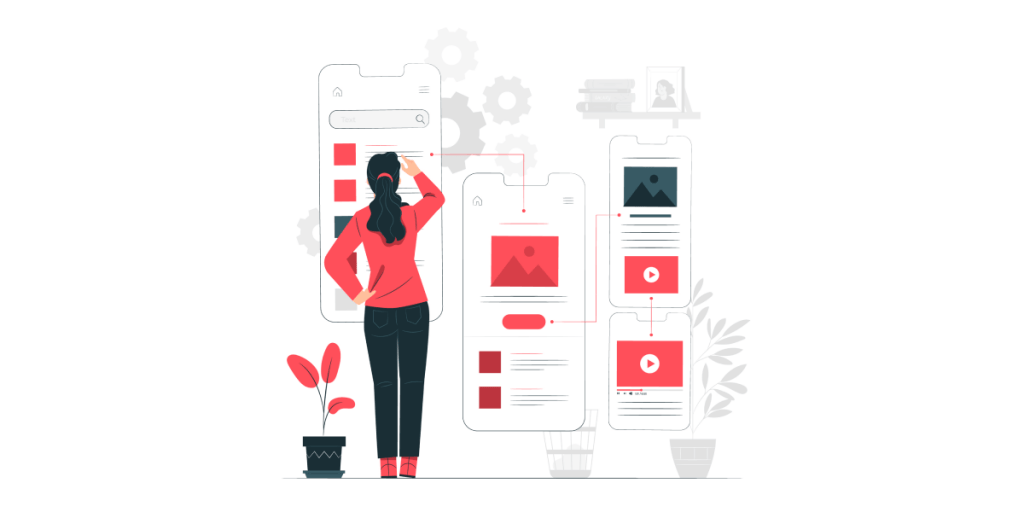Why is User Interface Design Important for User Engagement?
Online businesses should understand the importance of user interface (UI) design and website usability. A great executed UI is accomplished through custom development as it is a vast and creative field. It has been proved that user interface design is a fundamental tool that increases user engagement. User engagement and user experience (UX) are the main selling factors. The way your target audience feels while navigating your website determines the success or the fall of your business.
In this article, we will explore how you can improve your website’s interface design and boost your user engagement. Follow along to gain more knowledge about this topic.
What is User Interface Design?

UI design incorporates all the visual aspects of websites such as colour schemes, fonts, images, animations, etc. These elements play an important role in making users feel comfortable. They also help them navigate easily from one page to another. In addition, they make sure that all content is presented clearly for visitors. This helps increase conversion rates by ensuring that there is no confusion among customers.
The focus of user interface design is to predict the user journey on your website and make sure that your website is easily accessible and coherent. UI assembles three key concepts: interaction design, visual design, and website architecture.
When choosing your website’s interface elements, make sure you are consistent, and the layout is predictable. By doing so, people can perform and complete the actions they want (subscribe to your newsletter, download an ebook, purchase goods, etc.), do it efficiently and gain a high level of satisfaction.
What is User Engagement?

User engagement refers to the degree of involvement and interest a user has in a website or application. It can be measured by looking at how often users return, how often they buy from you, and how much time they spend on your website. The more engaged a user is with your app, the higher their likelihood of returning and buying will be.
Engaged customers have higher lifetime values than non-engaged users. They also tend to spend more money with your business over time. If you’re not engaging them, it could cost you thousands of dollars each month. 86% of buyers are willing to pay more for a better customer experience.
The most asked question from our clients is, “How do I engage my target audience?” The answer is simple, but the implementation needs effort, time and resources. No matter your business model, we all have the same goal: to keep our customers happy. We consider user experience to be the element that makes or breaks the success of an online business. The user experience or UX refers to how a website feels and functions when it’s being used. It includes everything about the way people interact with a website, from its appearance, navigation and usability, to website performance, page speed, functionality, security, accessibility, and more. The goal here is to create a positive user experience to get higher conversions and increase the number of loyal customers.
Why is User Interface Design so Important for User Engagement?

In a constantly growing online world where companies are starting to realize the importance of a good user experience, digital products with a good user interface gives you a competitive advantage. As a result, they are creating highly functional and polished solutions while providing a positive experience to online users.
When we talk about a good user interface, we refer to the website’s visuals. The UI visuals make a website or app approachable as it connects functionality with aesthetics. The user interface design is important because it influences how people interact with your product to achieve their goals and satisfy their needs.
The UI, together with functionality, are important in creating the interaction between your brand and customers. When the functionality of your website is combined with eye-candy visuals, customer loyalty and customer engagement increases. The design of your website, together with your product, should team up and make your brand stand out, define a specific problem for your target audience and make it easy to find. Incorporating this strategy into your UI design, your website will:
- Bring value as it will address users’ needs. Defining your target audience and positioning your business in the market are crucial steps. The user interface will enhance the value of your product.
- Make your product accessible for your users. You should clearly define the user intent and help your user personas fulfil their goals and needs. Once the intent is achieved, the design will help you properly scale your product.
- Have a timeless feel by implementing a solid and relatable design that fits your digital product. To create a positive customer experience, the customer journey should be smooth and focused on solving their pains and achieving their goals.
- Be intuitive. When users have to think about what they are doing and search for a long time to find what they are looking for, it will create a bad experience. Your UI team should know in detail how the users will interact with your app and minimize the amount of time for completing their goals. This will guarantee that your audience will finish what they want to do without leaving your website or asking themselves how to do something.
- Look and feel beautiful when your website or app is functional and satisfies a core need. When you look for a competitive advantage, you should deliver a beautiful aesthetic that completes your brand identity. Keep in mind that beautiful designs can go on the wrong side of user experience and complicate the customer journey map. Therefore, we recommend you think about guiding the user through their journey by highlighting the important information and making their experience effortless.
All the elements we mentioned in this chapter have an important role in user engagement, which leads to a fantastic user experience and a high conversion rate when implemented the right way. Customers who are fully engaged represent a 23% higher share in profitability, revenue and relationship growth.
User Interface Design Best Practices

To achieve the best user interface design that keeps customers engaged, increases customer satisfaction, and provides an amazing digital experience, you should take into consideration some factors and best practices:
- Usability and likability – your user base judges the design quickly based on how fast they can complete their goal with minimum effort. Therefore, your design should accommodate user flows. We strongly recommend you study customer journey mapping. The most fine-tuned and intuitive is the UI design, the more engaging the user experience.
- Enjoyable user journey map – UI design should be enjoyable, satisfactory and frustration-free to users. When your design predicts user needs, they can have a more personalized and deeply engaging experience. If you surprise them, they will keep returning. 64% of the consumers expect tailored engagements that are based on their past interactions with a brand. We strongly recommend you think about elements of gamification and rewards to make your user interface more fun and interactive.
- Emphasis on brand values and strengthening user’s trust – a good UI design is able to transmit emotion, making users feel good when they interact with your brand and keep an overall pleasurable and seamless experience.
Impressive user interface designs have at core the fact that online visitors are human and try to make their journey as comfortable and flowy as possible. We recommend following the next best practices to ensure a smooth user experience:
- Your action buttons and elements should be predictable. Users should be able to use them everywhere without putting too much thought into their actions.
- Your website or app should be highly discoverable. Everything that’s on your pages should be clearly labelled and visible to users.
- Keep it simple. Use only elements that are serving the user’s purposes.
- Concentrate the attention on hierarchy and readability. Remember that your website or app is designed for the human eye. Your layout should include proper alignment and draw the eye on key features. We suggest focusing on colour, brightness, contrast, font size, bold, italics, capitals, etc. Users should be able to understand what’s on your page just by a quick scan.
- Reduce the number of actions that users must perform on your site. Focus on one key action per page and guide your users by indicating the chosen actions.
- Use action buttons near the objects that users want to control (ex.: use a “Submit” action button near a registration form).
- Display responses or feedback. When a user performs an action to your website or app, display feedback or response messages so they know what to expect next.
- Use UI design patterns where possible. For example to pre-fill a form.
- Maintain brand consistency across all your communication channels.
- Make the user journey predictable. Provide the next steps that are natural for users. Try to simplify their journey, not complicate it.
Our Advice

As 54% of online customers think companies need to transform the way they engage fundamentally, we have some advice on doing just that.
First of all, you should know what your customer base considers valuable. It can be anything from a utility to daily deals. We recommend starting with A/B testing and extract the data that gives you answers on which action is repeated the most. Identify the key moments in the customer journey and deliver exactly what they expect. All in all, you need to figure out how to create experiences that people will love.
Focus on the interface’s usability. Even though increasing user engagement seems like a duty for the marketing team, the truth is that the most important factor in boosting engagement is the website or app’s interface. Users expect simple and effective interfaces. If they don’t like the usability of your website, they will seek alternatives until their needs are satisfied. Our advice is to monitor the drop-off moments from the user’s journey and fix that usability issue. For example, on an eCommerce website, the drop-off moment can be on the checkout page. In this case, you can analyze why a significant number of customers abandon their carts. Maybe they don’t want to create an account, and you don’t have the check out as a guest option, the checkout process is too long, or you don’t have enough payment options. By simplifying your user’s journey, you increase engagement and, in the end, your sales.
Increase engagement by educating your customers. Remember that your product is discovered daily by new users. Engage them with useful information, recommendations, shortcuts to your products, customer chat, FAQs, etc. Users must find what they are looking for quickly and intuitively. This will bring the value they are looking for, and the risk of losing them gets lower.
Another factor that we consider extremely important is to let customers share their experience with your company. Your marketing team should reach out to them and ask for feedback, reviews, even their pain points. You can also engage and bring back your target audience via push notifications, emails, messaging, etc.
We highly recommend paying attention to your user’s journey when designing the interface. Custom development may bring tremendous value to your company and help you reach your business goals faster and easier. If you are looking to start your online business or you are looking to improve your website or app’s UI design, do not hesitate to contact us. We are a full-service digital agency with over a decade of experience and a large portfolio of clients from various industries. Check out our Clutch profile and read all about the experience our previous customers had working with us. Let’s start working on your project together and you will see how your business reaches new highs.
Frequently Asked Questions
We recommend you keep it simple and choose common elements. By doing so, users feel more comfortable and are able to get things done more quickly. Keep consistency and adapt the UI elements to your brand’s colours and feel.
All of them. User engagement is a necessity. You cannot function as a business if your customers aren’t happy.
Because users are the ones that decide the success of your business. If they are not engaged with your brand, they will not convert into customers.
We recommend analyzing several metrics such as time on site, new vs returning users, page views, top content and bounce rate.